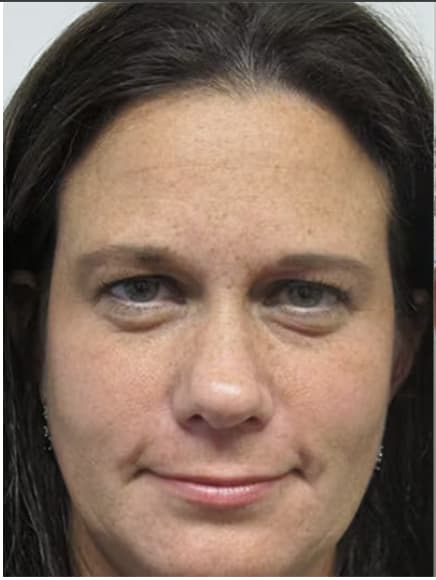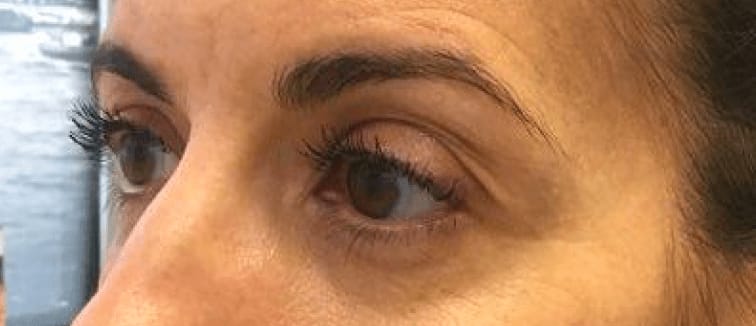
The Skinny
According to The American Society for Aesthetic Plastic Surgery, there were 22,713 brow lift procedures performed in 2017. A qualified board-certified plastic surgeon can help determine the specific type of brow-lift technique that may work best for you to lift your eyebrows from a saggy position, which can at times cover the vision or bring an aged “mean” appearance.
The American Board of Cosmetic Surgery notes that brow lifts affect the area above the brows, while eyelid lifts improve the area around the eyes. Facelifts, on the other hand, focus on the region of the face surrounding the middle or lower portions, while a neck lift improves the collar bone and chin area.
An experienced plastic surgeon will also be able to determine if eyelid surgery would better suit you instead of or in addition to a forehead lift since brow lift surgery won't alleviate the crow's feet type of wrinkles around the eyes or baggy eyelids.
As reported by Johns Hopkins Center for Facial Plastic and Reconstructive Surgery, patients from ages 40 to 60 are the ones most likely to undergo an eyebrow lift.
AEDIT
Before & After Images by Provider












Before & After Images by Provider
Brow Lift Solutions
The Specifics
Ideal Candidates for Brow Lifts
The ideal candidates for brow lifts may vary, based upon the type of procedure being considered. In general, potentially good brow lift surgery patients include the following:
Who Should Not Get a Brow Lit?
Certain individuals may not be good candidates for brow lift surgery, but consult your physician regarding the following conditions:
How Much do Brow Lifts Cost?
According to the American Society of Plastic Surgeons, the average cost of a brow lift in 2017 was $3,374. However, that amount does not account for additional costs associated with brow lift surgery, such as the expenses incurred for medical history tests, surgical anesthesia, facility fees for the cost of the operating room, along with other expenses for prescription medication and recovery needs.
Since the types of brow lift surgeries vary widely, along with the fee charged by the facial plastic surgeon based on his or her location and level of experience, brow lift costs can run the gamut. A brow lift's cost can range from $300 up to $14,000. With the average cost roughly around $7,150.
Invasive brow lift surgeries such as the coronal, pretrichial, traditional, direct brow lift, and even an endoscopic brow lift can range in cost from $4,000 to $7,000. At times patients choose to combine their brow lift procedure with additional treatments.
Botox® brow lifts are less expensive, ranging from $100 to $1,000 per treatment, based on how many injections of Botox® are used. Brow lifts gained via Botox® injections require upkeep costs since the results are not permanent.
In general, brow lifts undertaken for cosmetic reasons likely will not be covered by personal medical health insurance, yet a plethora of plastic surgeons offer financing options for their patients. To better understand the price of the procedure, check out our complete guide to brow lift cost.
Brow Lift Recovery
Recovering from brow lift surgery is also largely dependent upon the type of surgery experienced. A board-certified plastic surgeon who has extensive experience in guiding patients through the recovery periods from their brow lift surgeries will provide post-operative instructions to help individuals ease into their after-surgery care and heal properly.
The time it takes to recover from invasive brow lift surgery can be shorter or longer for some patients, but overall, patients can expect some of the following during their recovery period:
To better understand the healing and downtime associated with the procedure, check out our complete guide to brow lift recovery.
Before & After Brow Lift Care
The method of preparing for brow lift surgery should be fully understood by the patient well before the procedure, to experience the best results. Whether undergoing an endoscopic lift or more invasive means of brow lift surgery, patients should be armed with the following knowledge.
Prior to Brow Lift Surgery
Weeks before getting brow lift surgery, a patient should be instructed by their plastic surgeon to perform tasks such as the following:
After Brow Lift Surgery
Types of Brow Lifts
The use of dermal fillers can help fill out and prevent forehead wrinkles, improving the brow area. In combination with fillers, Botox® is even used as one of the methods of lifting the brows, as you'll discover in the following sections. However, brow lift surgery can lift the eyebrows, forehead, and upper eyelids in a dramatic fashion that helps frown lines decrease. A cosmetic surgeon who specializes in facial plastic surgery can cause a more youthful appearance and a welcoming facial expression to appear via a brow lift procedure.
Find out next about seven main types of brow lifts, from the traditional and invasive form of cosmetic surgery for the brows to the less invasive endoscopic brow lift and beyond.
1: Coronal Brow Lift
The coronal brow lift is named as such because "coronal" relates to the "crown" of something - in this case, the head. With a coronal brow lift, which is often called a forehead lift, the long incision site runs from one ear to the other ear across the top of the head, like a headband. The facial plastic surgeon makes the long incision in the portion of the scalp that is hidden by the hair, and the surgical procedure bevels the incision site in an attempt to protect the hair follicles from being harmed.
A refreshed appearance is then created when the brow area is manually lifted along with underlying muscles, and excess skin is removed to create a smoother forehead. Patients who have extremely high foreheads may respond better to an anterior hairline incision site, which allows for a brow lift that doesn't change the hairline height, but may leave more visible scars that can be covered with bangs.
2: Endoscopic Brow Lift
An endoscopic brow lift usually involves four to six small incisions being placed within the scalp, behind the hairline. The cuts make room for an endoscope to be inserted to allow the facial plastic surgeon to see muscles and tissue via the camera attached to the tube-like device. The small incisions also allow space for the muscles to be moved or cut in a manner that provides a forehead and brow lift.
Extraneous fat and tissue can also be extracted during the surgery, while the brows are lifted as well. The endoscopic procedure creates fewer scars than the traditional forehead lift with the long incision, therefore recovery time is shorter. Because of these advantages, the endoscopic lift is the most common form of incision type used during brow lifts.
3: Pretrichial Brow Lift
A pretrichial brow lift places the incisions along the hairline in the front, or close within the front of the hairline. Your pretrichial incision site will be based upon factors such as the shape of your forehead and hairline.
Individuals who have foreheads which are extremely curvy, or people with high hairlines, should get a pretrichial lift with the incision placed in a short central location, combined with an endoscopic forehead lift.
Select surgeries can be performed at the same time. Traditional pretrichial forehead lifts could be done in conjunction with a facelift, and the facelift incision could join the brow lift incision.
4: Combination Mid-brow Incision with Endoscope Brow Lift
There are times when a combination of techniques works best for specific patients, such as an endoscopic brow lift used in combination with a "mid-brow" incision that is hidden in a forehead crease.
An endoscope can then be used to view beneath the brow area as the surgeon manipulates the underlying muscle, tissue, and fascia as needed. A variety of surgical tools can be utilized to create suspension and trim any excess fat and tissues.
5: Traditional Mid-brow Lift
Another method of performing a lift from the middle of the eyebrow area is the traditional mid-brow lift, which isn't used as often as an endoscopic lift, but it also creates an incision within the patient's forehead crease. The incision site may help the surgeon precisely target the area for brow lifting and removal of excess skin, but a mid-brow lift creates incisions in a very visible location.
Yet and still, the traditional mid-brow lift allows for flaps of skin to be raised to perfect the brow position and to correct crooked or asymmetrical eyebrows.
6: Direct Brow Lift
A direct brow lift is one of the brow lift techniques that involves incisions directly atop the eyebrow hairs to attempt to hide the scars therein, according to the Review of Ophthalmology. The direct brow lift procedure is not as common as it once was, but can still be useful for certain patients who require specific corrections in the functionality of their brow areas.
The direct brow lifting technique can be effective, although it is often not used because of the potential for visible scars. In general, the direct brow lift is often reserved for older or male patients who have thick bushy eyebrows that can more readily hide the scarring. The study included 50 men who had direct brow lift surgery, along with upper eyelid blepharoplasty surgery.
Overall, the direct brow lift was determined to help brow height asymmetry greatly because of the superior level of control is provided to reverse drooping eyebrows. The results proved that the direct brow lift technique also provided long-term results for bald men and those with high hairlines.
7: Chemical Brow Lift
A chemical brow lift uses substances like Botox, instead of incisions and sutures, to lift the eyebrows. Botox® can be injected into specific areas to relax muscles that pull the brows downward. Botox® injections can cause the patient to be unable to contract those specific muscles, which in turn can minimize wrinkles.
Shaping the brows with Botox® necessitates a deep understanding of how the underlying muscles perform and can have a limited effect upon raising the brows when compared to surgical methods. However, plastic surgeons and expert injectors who specialize in the procedure can use a combination of Botox® and dermal fillers to raise and shape the brows in a way that offers a beautiful aesthetic without surgery.
The Takeaway
The Pros and Cons of Brow Lift Procedures
Although various types of brow lift surgeries can be accompanied by advantages and disadvantages, overall, individuals who discover their countenances improved at the hands of a skilled plastic surgeon love how a brow lift can take years off their appearances and make them look wider awake and happier.
The following are the pros and cons of different types of brow lift procedures:
The Pros and Cons of a Coronal Brow Lift: The benefits of a coronal brow lift include the fact that the long incision can be hidden in patients who have plenty of hair. It also offers the physician open access to the muscles of the forehead and can provide a permanent way of lifting the brows and forehead without much scarring.
However, the disadvantages of the invasive coronal brow lift surgery mean that it can raise the hairline for patients who don't want a higher hairline. The coronal brow lift also doesn't address brow asymmetry and can cause hair loss at the incision site, a numb feeling, swelling, and possible headache pain.
The Pros and Cons of an Endoscopic Brow Lift: The less invasive endoscopic brow lift has the advantages of hidden incisions, a shorter surgery period, as well as offering the surgeon good access to muscles in the forehead.
However, an endoscopic brow lift can also raise the hairline, and potentially cause pain, swelling, hair loss, and a "pins and needles" feeling in the scalp.
The Pros and Cons of a Pretrichial Brow Lift: A permanent pretrichial brow lift has the benefits of not raising the hairline and offering scars that can be hidden well, along with giving the surgeon a good way to access the forehead muscles. However, the pretrichial brow lift can be harder to perform, and still comes with the risks of scars that can be seen, possible hair loss, pain, numbness and the "pins and needles" sensation.
The Pros and Cons of a Combination Mid-Brow Incision with Endoscope Brow Lift: When a mid-brow incision is used in combination with an endoscope, the surgeon gains direct access to the muscles of the forehead and scars might be well hidden. Conversely, the procedure can elevate the front hairline and potentially leave scars, cause hair loss, numbness, and the "pins and needles" problem.
The Pros and Cons of a Traditional Mid-Brow Lift: A traditional mid-brow lift can work well for certain patients who benefit from the fact that the plastic surgeon can precisely determine where to elevate the eyebrows. It can also offer a way to trim any excess skin selectively.
However, the mid-brow lift still comes with the risk of scarring, and certain patients may discover that their brows could droop once more over some time. The mid-brow lift might also cause certain individuals to experience a changed sensation in their foreheads.
The Pros and Cons of a Direct Brow Lift: A direct brow lift offers exact brow elevation and may have even fewer side effects than some of the previously mentioned surgeries.
However, the direct brow lift surgery may cause droopy brows to return after a while. This type of surgery may also cause distortions with any deep furrows that already exist in the forehead. Other side effects include the possibility of an altered feeling in the forehead, as well as numbness and scarring.
The Pros and Cons of a Chemical Brow Lift: Botox® brow lifts are known to have the advantages of being an easy and less expensive way to reduce the look of fine lines and gain a smoother forehead without undergoing the rigors of surgery.
However, the advantages of the non-invasive injections are joined by the fact that the Botox® benefits are only temporary, requiring multiple treatments to continue experiencing the benefits as the Botox® wears off. In the hands of an unskilled injector, or a patient who doesn't properly follow after-care instructions, Botox® brow lifts may cause droopy eyelids or the overly arched "Spock Botox brow" appearance. Other side effects may include infection in the wake of the Botox® injections, or pain, swelling, redness and bruising.

